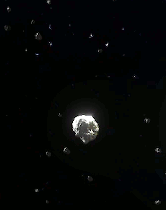Autopilot Features
| Name | ARL | AAT | RTC | FBW | Capabilities | Price |
|---|---|---|---|---|---|---|
| MLF Autopilot | ☑ | LIDAR highlight | 10,000 E$ | |||
| MA-337 Autopilot | ☑ | ☑ | LIDAR overlay | 27,000 E$ | ||
| NDCI Autopilot | ☑ | ☑ | Firing solutions, Collision warnings | 60,000 E$ | ||
| ER-42 Autopilot | ☑ | ☑ | ☑ | ☑ | Trajectory prediction | 100,000 E$ |
| EIAA-1337 Autopilot | ☑ | ☑ | ☑ | ☑ | Autonomic | 150,000 E$ |
Systems
MLF Autopilot
The MLF is a basic autopilot module capable of preserving velocity and orientation of the craft, using simple heuristics to determine RCS fire. The widely available open-source Antipodal Reaction Limiter module is used to cancel out opposing inputs. This autopilot is not capable of adjusting to changes in mass or thrust configuration. -In-game Description
The starting autopilot system when starting a new game. Does not consider the mass of chunks inside the cargo hold when making maneuvers.
LIDAR Highlighting
When a small enough ringroid is destroyed, the MLF will automatically highlight floating ore chunks with a rectangular box over said ore chunk withing the players view, allowing for easy identification of chunks.
MA-337 Autopilot
The proprietary autopilot module of Mitsudaya-Starbus, the MA-337 can be retrofitted to most modern craft. It uses advanced heuristics combined with a pre-trained Adaptive Angular Thrust neural network to adapt to mid-flight changes to ship configuration, mass shifts, and thruster damage. -In-game Description
The next tier of autopilot; which considers the weight and shifting mass of chunks in the cargo hold when making maneuvers.
LIDAR Overlay
When autopilot is engaged, an overlay of the LIDAR system is displayed outside of the autopilot "bubble", allowing for quick reference to the LIDAR.
NDCI Autopilot
The NDCI autopilot is a decommissioned and gentled military-grade artificial neural network, used as the autopilot system in Tsukuyomi-class frigates. Rotational Thrust Computation capabilities allow it to accurately process and predict the impact of thrust alignment on rotation, for faster heading adjustments and less unintentional rotation. Its integration with standard Head-Up Display systems exposes its internal tactical assessment to the pilot. An integrated Fly-By-Wire system can interpret and augment direct thruster commands. The demilitarized system is not capable of full autonomy. -In-game Description
This autopilot system uses more reaction mass compared to previous systems, in exchange for quicker acceleration and movement of maneuvers.
Firing solutions
Each weapons (railgun, laser, microwave, etc.) firing arc is shown to the player, showing the player where each weapon will hit, be it ringroids or other ships. The Firing solution also follows the aim of gimbled weapons.
Collision warnings
When traveling at a speed were impacting an object would cause damage to the ship, lines from the ship to the object are displayed, shifting from orange to red depending on the proximity of the object. These warning also consider the orientation of the ship, and display where the object would hit the ship in the event of an impact.
ER-42 Autopilot
This custom-built autopilot was designed specifically for ring racing events. It offers superior trajectory prediction and has an unparalleled suite of capabilities, but requires fully operational high-resolution sensors to work reliably. -In-game Description
This autopilot system needs to be unlocked from an event out in the ring before it can be installed on the ship. This autopilot is also only one of 2 systems that support all Reaction Control Systems avaliable in the game.
Trajectory prediction
When moving at speed, a highlight of the ship is displayed in the direction of travel, showing the predicted direction of travel ahead of time. This prediction also bends and rotates according the direction & thrust the ship is heading.
EIAA-1337 Autopilot
This MIT-licensed autopilot module for the Model E was released stand-alone to "accelerate the advent of interstellar travel". Its retrofit costs include the complete required sensor package. While still in the early stages of testing, the Elon Interstellar Autonomous Autopilot is a sophisticated and adaptable autopilot assist system, even in crowded spaces or enclosed docking structures, at speeds up to 50m/s. Elon Interstellar is not responsible for any damage, injury, or death incurred due to operating the system outside its specified operating parameters. THE SOFTWARE IS PROVIDED "AS IS", WITHOUT WARRANTY OF ANY KIND, EXPRESS OR IMPLIED. -In-game Description
A "true" autopilot, allowing for the ship to automatically avoid obstacles while maintaining the same direction of travel. Does not give direct control of the autopilot unless actively controlling the autopilot vector.
Autonomic
Simply tell the autopilot the heading you wish go with the autopilot vector, and it will navigate automatically. For direct control the player must actively left-click-drag or right-click-drag the autopilot vector. Selecting an object with autopilot will navigate the ship towards the object, as well as open the excavator if the object is an ore chunk when close enough.
Reaction Control Systems
ARL
Antipodal Reaction Limiter cancels out opposite thrusters, reducing remass consumption while preserving same effective thrust.
AAT
Adaptive Angular Thrust checks how much rotation thrust ship needs in realtime, as mass shifts within cargo bay. It makes it capable to steer ship with big cargo bay full of shifting mass.
RTC
Rotational Thrust Computation uses dynamic equations to figure out which thrusters will contribute to rotating ship. It makes use of non-obvious thrusters, using more reactive mass but generally will end up with faster angular acceleration.
FBW
Fly By Wire routes usual "manual" thrust input through an autopilot, allowing it to make corrections and fire other thrusters than user anticipated. Makes manual flying easier, but will most likely use more reaction mass.
